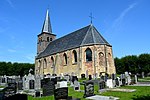Kramersmolen, Goutum
Hollow post mills in the NetherlandsRijksmonuments in FrieslandWindmills completed in 2002Windmills in FrieslandWindpumps in the Netherlands

Kramersmolen is a hollow post mill in Goutum, Friesland, Netherlands which was built in 2002. The mill is listed as a Rijksmonument, number 24508.
Excerpt from the Wikipedia article Kramersmolen, Goutum (License: CC BY-SA 3.0, Authors, Images).Kramersmolen, Goutum
Swettepaad, Leeuwarden
Geographical coordinates (GPS) Address External links Nearby Places Show on map
Geographical coordinates (GPS)
| Latitude | Longitude |
|---|---|
| N 53.175555555556 ° | E 5.765 ° |
Address
Kramersmolen
Swettepaad
8912 BK Leeuwarden
Frisia, Netherlands
Open on Google Maps










